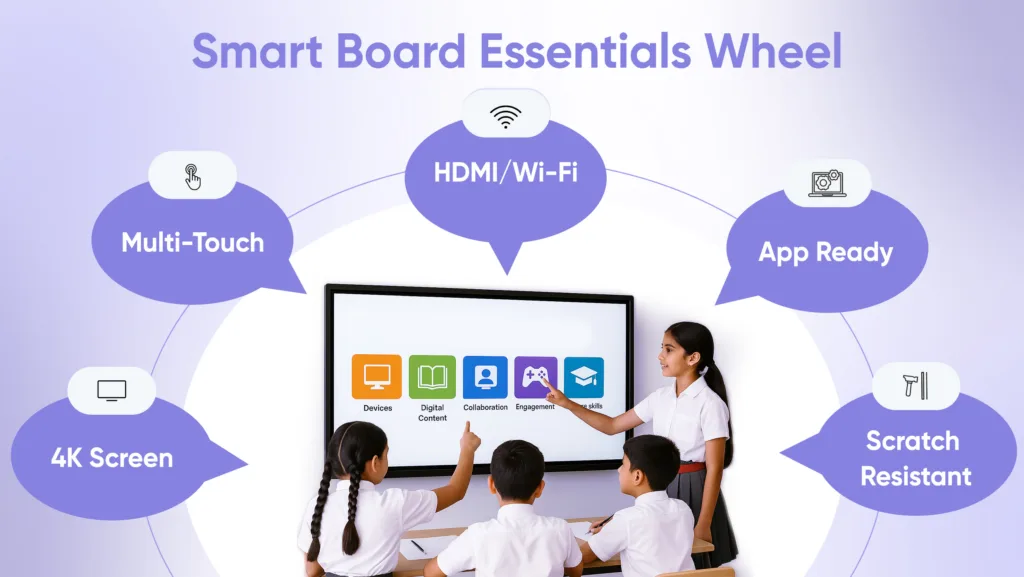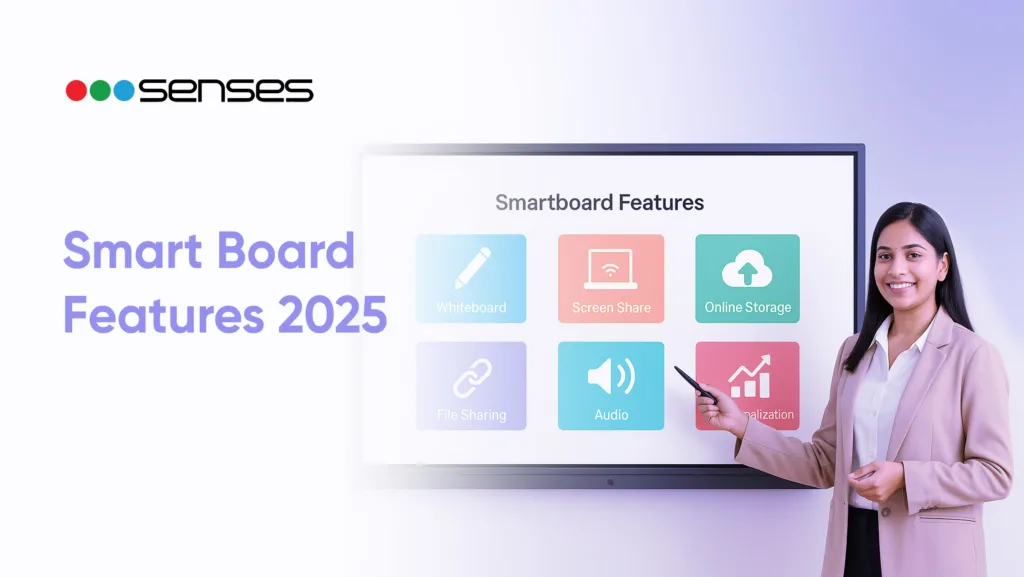A smartboard is a large, touch-sensitive digital board that allows teachers and students to interact using fingers or styluses. Smart boards are reshaping both teaching practices and learner interactions with content.
With modern features, interactivity, and software having single- and multi-user interaction, smart boards are now foundational in schools, colleges, coaching centres, and potential business applications.
By familiarising yourself with smart board capabilities and specific requirements, educators and decision-makers will ultimately be able to make informed decision about a new smart board.
👉 Are you looking for the best classroom smartboards? Check out Senses Electronics‘ smart boards designed for next-generation teaching and learning.
Key Takeaways:
- Smart boards enhance classroom interaction and participation.
- Selecting the proper size and resolution allows for better visibility.
- Having the right connectivity and compatible software is necessary.
- Durability and low maintenance mean longevity.
- Senses Electronics smart boards provide all of this and are made with future-ready technology.
What is a Smart Board, and Why Do Features Matter?
Digital interactive whiteboards, known as smart boards, integrate a display, touch, and connectivity to create a more engaging classroom experience. Display features matter because they can affect, in real time, student engagement and participation, instructional efficiency, and the durability and sustainability of the device.
Importance of Features in Teaching & Learning
The right features ensure smoother lessons, compatibility with digital content, and better collaboration between students and teachers.

Key Smart Board Features for Classrooms
Smartboards have many essential features that qualify them for teaching and learning. The features provided add to the ease, engagement, and collaboration of the classroom experience for both teachers and learners. The next features are the essential ones to consider here:
Quick View Table: Features of Smart Board in Teaching & Learning
| Feature | Description | Classroom Impact |
| Interactive Lessons with Visuals | Use of diagrams, images, and videos for teaching | Makes lessons more engaging and easier to understand |
| Real-time Collaboration | Multiple students can write/draw on the board together | Promotes teamwork and active participation |
| Accessibility for Learning Styles | Supports visual, auditory, and hands-on learning | Helps all types of learners grasp concepts better |
| Digital Resource Integration | Easy access to e-books, presentations, and online tools | Saves time and enriches the teaching process |
1. Display Quality & Screen Size
Display quality affects visibility and clarity for student viewing. A higher resolution like Fl-Hd or 4K provides clarity in the images and text to provide a clear path for students to follow during lessons.
2. Touch & Writing Features
Smart boards should enable multiple user intervention at the same time, usually allowing 10 or more touch points at once. Smooth tactile writing with a stylus or fingers, palm erasing, and pressure sensing make for more engaging and authentic teaching experiences.
3. Connection Options
Good connection options allow for seamless integration with many classroom devices. HDMI, USB, Wi-Fi, and Bluetooth are essential connection options, along with opportunities for wireless screen mirroring. These connection options help integrate laptops, phones, and tablets easily and quickly while teaching.
4. Compatible with Educational Applications
The board should be compatible with Google Workspace, MS Office, and learning management systems (LMS). Built-in annotation capabilities, split-screen options, and recording options make teaching versatile and easy to implement.
5. Integrated Educator Utilities
Tools such as annotation writing implements, screen splitting, lesson recording, and in-class assessment tools create teaching ease and engagement with students.
6. Durability & Maintenance
Smartboards should be durable with anti-glare, scratch-resistant glass. In addition, energy efficiency is essential. Smartboards that are durable and use less energy will, ultimately, last longer and require the least amount of upkeep over time.

Smart Board Specifications You Should Check
Technical specifications dictate performance, responsiveness, and usability in various teaching contexts.
- Screen Resolution: Where possible, full HD or 4K displays offer sharp visuals, particularly in larger teaching spaces.
- Touch Sensitivity & Multi-User Interaction: You will want a board with multi-user touch capabilities so that it will lend itself more to group work and cooperatively engaging activities.
- Audio & Visual Support: Speakers built into the board with a sound output of 20W, allowing for microphones and external cameras integrated into the setup, can help establish a successful platform for digital learning.
- Storage, RAM, and Operating System: It will be helpful to make sure the board has a sufficient amount of RAM, storage, and an operating system that is compatible with particular educational applications.
Features of Smart Board in Teaching & Learning
Smart boards are more than displays they enhance teaching and learning in a way that makes lessons livelier and more productive. Here are the main ways smart boards function:
| Features | Description |
| Interactive Lessons through Visuals | Teachers can include diagrams, images, and videos to help clarify difficult subjects and create interest. |
| Accessibility for Different Learning Styles | Whatever is the preferred way of the student to learn, whether by seeing, listening, or doing, smart boards can provide that by relying on visuals, audio, and tasks that are interactive. |
| Collaboration in Real Time | Multiple students can write or illustrate a response on the board simultaneously. allowing for cooperation and collaboration in group problem solving. |
| Integrate Digital Resources | Smart boards provide an easy way to integrate e-books, presentations, and online tools in a quick way that brings depth and clarity to lessons. |
Smart Board Features and Uses in Different Setups
Smart boards are not restricted to schools; they are commonly used in several industries.
- Schools & Colleges: Ideal for interactive lessons, flipped classrooms, and digital assessments.
- Coaching Institutes: Increase engagement for competitive exam preparation with split-screen diagrams, problem-solving, and mock assessments.
- Business & Training Rooms: Improve presentations, brainstorming, and distance collaboration.
Smart Board Buying Guide for Schools
Selecting the best smartboard will largely depend on features, pricing, and the reliability of long-term support.
- Pricing vs. Features Trade-off: You will want to balance the affordability of the product with some of the specifications that are important, like size, resolution, and connectivity.
- Classroom Size & Suggestions: Choose the size of the smartboard based on the number of students and space requirements.
- Warranty & Support: Consider a warranty of at least 3 years, as well as the ongoing after-sales and training support that your school will have/need.
Long-Term Price Efficiency: Also consider the costs of whether the software has ongoing updates, training, and maintenance, etc.

Free Download: Smart Board Features Checklist (PDF)
To simplify your decision, we’ve created a ready-to-use checklist covering all essential smartboard features.
👉 What this checklist includes:
- Display & size requirements
- Touch & writing features
- Connectivity options
- Software compatibility
- Audio-visual features
- Durability & maintenance
- Buying considerations
📥 Download the Smart Board Features Checklist and evaluate your options. Senses Electronics smart boards meet all the essential criteria.
Why Choose Senses Electronics Smart Boards?
Senses Electronics provides comprehensive boards designed specifically for modern classrooms and training settings.
- Specifications Built for the Future: 4K resolution, AI-powered tools, and sophisticated interactivity.
- Seamless Compatibility with Teaching Tools: Seamlessly works with LMS, Google Workspace, and MS Office.
- Sustainable & Built to Last: Low power draw, toughened glass, and a long life.
- Trusted by Schools & Institutions in India: Hundreds of institutions put their trust in Senses Electronics to update their classrooms.
👉 Update your classrooms with Senses Electronics Smart Boards. Call us today and find solutions for your school.
Conclusion
Smart boards have established themselves as a vital resource for modern classrooms, coaching centres, and even businesses. When they are the right ones with the right features, specifications, and durability, they have been shown to heighten student engagement and facilitate better teaching.
Want to find the right smartboard for your classrooms? Connect with Senses Electronics to help you find the right product with the right solutions for the future.
FAQs
The main features include durability, software compatibility, touch sensitivity, connectivity, and display quality.
Some important specifications to consider are the size of the board, resolution, operating system, storage/storage capacity, connectivity, and multi-touch.
The benefits include increasing student engagement in their classrooms, collaboration amongst students, and integrating digital resources.
Small classrooms would be 55″ to 65″, medium classrooms would be 65″ to 75″, and large classrooms would be 75″ to 86″.

